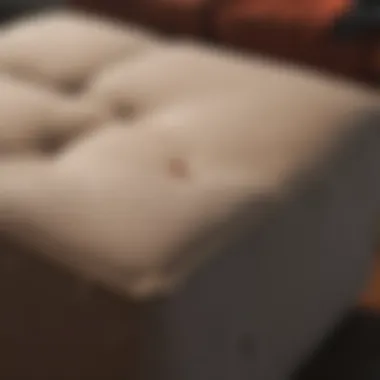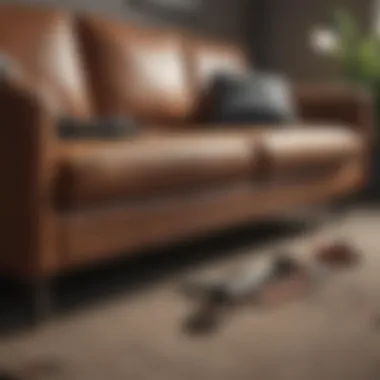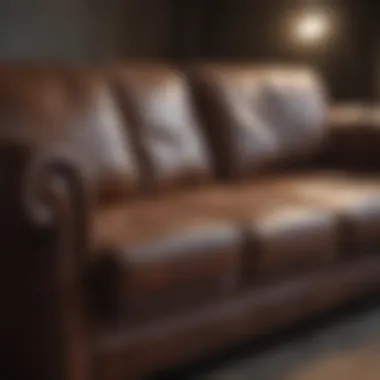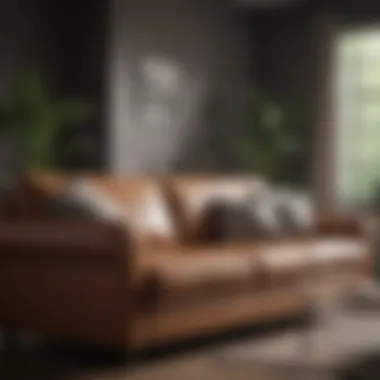Expert Techniques to Repair Your Broken Couch


Intro
Couches are essential pieces of furniture, providing comfort and style to any living space. However, wear and tear can lead to various issues that diminish their functionality and aesthetic appeal. Understanding how to repair a broken couch is crucial for homeowners and design enthusiasts alike. This article lays out methods for addressing both common and complex problems, guiding you through necessary tools, materials, and step-by-step instructions. By following this guide, you will learn how to identify damages, select suitable repair techniques, and maintain your couch, ensuring it not only serves its purpose but also enhances your living environment.
Design Inspiration
While the focus of this article is on repairs, the appearance of your couch can significantly affect the overall vibe of your interior space. A well-maintained couch not only looks inviting but also reflects the current interior design trends that emphasize harmony and aesthetic appeal. Understanding these trends can inspire your repair efforts and encourage creativity in your home.
Current Interior Design Trends
Contemporary interior design often highlights minimalism, sustainability, and personalization. Couches today lean towards clean lines and multifunctionality. Therefore, when selecting materials for repair, consider options that align with these trends. For instance, using eco-friendly fabrics or finishes can enhance your couch's appeal while supporting a sustainable lifestyle.
Color Palettes and Their Effects
Color plays a pivotal role in how furniture is perceived. Before embarking on repair projects, consider how the colors of your couch interact with surrounding items. Neutral tones often create a serene atmosphere, while bold colors can serve as focal points. When choosing repair materials or new fabric, aim for colors that harmonize with your existing decor, fostering a cohesive look that welcomes guests.
"A well-chosen color palette can transform a room, making the atmosphere not just livable but also enjoyable."
Make sure the newly repaired couch fits perfectly into your design scheme. If you opt for a vibrant tone, it could serve as a conversation starter. Similarly, calming colors can promote relaxation in busy areas of the home. Keeping these aspects in mind while planning repairs will enrich your living spaces.
Tools and Materials for Repair
Now that design inspiration is addressed, it’s essential to focus on tools and materials needed for repairs. Gathering the right items beforehand can streamline the process and optimize results.
- Tools:
- Materials:
- Screwdriver
- Stapler (for upholstery)
- Needle and thread (or sewing machine)
- Pliers
- Foam padding (for cushioning)
- Upholstery fabric
- Wood glue (for structural repairs)
- Wood filler (for fixing scratches or gouges)
- Spray adhesive (for attaching foam padding)
- Cushion covers (to revamp old cushions)
Being prepared with the appropriate tools and materials will significantly reduce repair time and improve the final outcome. This focus will ensure that your couch not only looks great but remains functional for years to come.
Maintenance Tips
After repairs are complete, it's vital to establish a maintenance routine. Regular upkeep can prevent future damage and prolong the life of your couch. Here are several tips to consider:
- Vacuum regularly to eliminate dust and debris.
- Spot-clean stains immediately to prevent them from setting.
- Rotate cushions to allow for even wear.
- Reapply protective sprays periodically to guard against spills and stains.
By applying these maintenance tips, you enhance the longevity and aesthetic appeal of your furniture, ensuring that your couch remains a centerpiece in your home for years to come.
Preamble to Couch Repair
Couch repair is a relevant topic for many homeowners and design enthusiasts. Sofas are among the most utilized pieces of furniture in any home. They endure daily usage, hosting gatherings, family movie nights, and providing a space to unwind after a long day. As a result, couches often face wear and tear, leading to various issues. Understanding how to repair these common problems benefits both functionality and aesthetics, extending the life of valuable furniture.
When addressing couch repair, several elements come into play. First, familiarity with the types of issues can make identification easier. Common concerns include worn out cushions, loose frames, torn upholstery, and even squeaky springs. By recognizing these problems early, homeowners can take steps to correct them, which saves money in the long run. Repairing rather than replacing not only reduces waste but also preserves the investment made in quality furniture.
There are numerous benefits to learning how to repair a couch. Firstly, this knowledge allows individuals to maintain their furniture, ensuring that it remains a stylish and comfortable centerpiece in their living space. Secondly, undertaking repairs can be a rewarding endeavor, as it provides a sense of accomplishment. Furthermore, such skills can also enhance one's overall ability in home maintenance, making other improvements more manageable.
Considerations regarding couch repair also include safety and suitability. Improper handling of certain tools or materials can lead to injuries or further damage. Thus, using the right methods, tools, and supplies is essential to achieve effective repairs. Importantly, there may be times when professional assistance is warranted, particularly in the case of complex issues that require specialized expertise.
In summary, the topic of couch repair encompasses both practical home maintenance skills and significant financial implications. By exploring methods to repair couches, readers can opt for sustainable solutions while gaining insights into maintaining their interiors.
"Investing time in learning how to fix your couch can save money and prolong its life."
Through this guide, we will delve deeper into common couch issues, essential tools, and comprehensive steps to address these challenges efficiently.
Identifying Common Couch Issues


Couches serve as the centerpiece of living rooms, providing comfort and style. However, they are not immune to wear and tear. Spotting problems early is crucial in preserving the life and aesthetics of your couch. Identification aids not just in maintaining functionality but also in preventing costs from escalating due to neglect. Recognizing symptoms of damage enables homeowners to act promptly.
Worn Out Cushions
Cushions are one of the most visible and prominent parts of a couch. Over time, they can lose their shape, firmness, and overall comfort. Common signs include sagging, flattened surfaces, or uneven support.
Replacing or re-stuffing cushions can revitalize your couch. Look for high-density foam or polyester fiberfill as restoration options. You might prefer adding a bit more padding for enhanced comfort. If cushions are removable, check for zippered covers that can be cleaned or replaced.
Consequently, maintaining fresh cushions not only improves comfort but also prolongs the couch's life.
Loose Frames
The frame of a couch bears the weight of the entire structure. Over time, it may loosen due to frequent use or inadequate assembly. Signs include creaking noises or instability when sitting down.
To fix a loose frame, inspect all joints. Tighten screws or bolts as needed. If parts are damaged, using wood glue may help reattach components securely. For structural durability, consider reinforcing corners with additional brackets.
Secure frames ensure long-term stability and prevent further damage, making this a critical identification point.
Torn Upholstery
Torn upholstery not only diminishes the couch's aesthetic appeal but can lead to more serious damage beneath. Tears, holes, or fraying fabric are common issues. Identifying the fabric type assists in determining the repair technique.
Depending on the severity of the damage, you might opt for patches, sewing, or even complete reupholstering. Patch kits often come in various colors and textures, enabling a better match to existing fabric. However, for larger rips, professional sewing might yield more satisfactory results.
Hence, identifying torn upholstery early allows for timely repairs, preserving the couch's appearance and usability.
Squeaky Springs
Squeaky springs are an annoying issue, often indicating that the suspension system is worn. This may present itself as a creaking noise when sitting or rising from the couch. It can be linked to various causes, such as loose screws or degrading support systems.
To address this issue, inspect the undercarriage. Tightening screws or applying lubricant directly to the springs can improve sound clarity. If springs are heavily corroded or damaged, replacing them may be necessary.
Identifying squeaky springs promptly can prevent further deterioration and maintain the couch's integrity, ensuring a quieter, more enjoyable seating experience.
Key insight: Recognizing these common couch issues early can save time and costs associated with deeper, more extensive repairs in the future.
Essential Tools and Materials for Repair
Repairing a couch often demands specific tools and materials to ensure the job is done correctly. Proper tools help facilitate the process and can enhance the effectiveness of repairs. Beyond efficiency, having the right supplies can also save time and prevent potential mistakes. Whether you are tackling minor repairs or addressing major issues, equipping yourself with essential items is crucial for achieving satisfactory results.
Basic Hand Tools
Basic hand tools play a fundamental role in couch repair. Common items such as screwdrivers, pliers, and a hammer are often used to open up the frame or secure loose components. Proper screwdrivers, including both Phillips and flathead, are particularly essential for adjusting and tightening screws that may have come loose over time. Pliers can be useful for gripping and twisting metal springs that are sometimes part of the support structure.
Furthermore, a staple remover is beneficial for taking off worn upholstery without damaging the underlying fabric. Having a measuring tape is imperative for ensuring that new materials fit correctly during repairs. Overall, these hand tools create a solid foundation for any repair undertaking, making the process smoother and more effective.
Upholstery Fabric and Supplies
When it comes to restoring a couch's appearance, upholstery fabric is key. Choosing the right material can improve not only the aesthetics but also the comfort of the couch. You may find that in some cases, a simple fabric replacement is sufficient to breathe new life into worn-out cushions. Fabrics like denim, canvas, or synthetic blends offer durability and ease of maintenance, making them ideal choices for high-traffic areas.
In addition to fabric, you will require padding materials. Foam padding can be cut to size for cushions, enhancing comfort significantly. There are various thicknesses to choose from, depending on the desired level of support. Using batting can also provide softness and improved visual appeal. These upholstery supplies allow for a refreshing update while retaining the original structure and comfort of your couch.
Adhesives and Fasteners
Adhesives and fasteners are often underappreciated but are critical for secure repairs. Wood glue, for instance, is essential for reinforcing connections in a loose frame. It's important to select a high-quality water-resistant glue to ensure that the joints hold over time. In addition, screws, nails, and brackets can be used in combination with glue to add additional strength to joints.
Safety precautions should also be taken when handling adhesives. Ventilation is important, especially with more potent adhesive products, to avoid inhalation of harsh fumes. Fasteners also require attention during the selection process. Selecting the right length and thickness of screws will prevent splitting the wood while ensuring a tight hold. The right combination of these elements ensures a long-lasting repair, which is especially beneficial for couches that endure constant use.
"Having the right tools and materials is not just about performing repairs well; it's about ensuring the longevity of your investments and maintaining a comfortable living space."


In summary, investing in the right tools and materials not only streamlines the repair process but also assures that the repairs made are durable and effective. As you prepare for couch repairs, remember to consider the importance of each category carefully.
Step-by-Step Guide to Repairing a Couch
Repairing a couch can initially seem overwhelming. Yet, a well-structured guide simplifies this task. This section outlines the importance of addressing damage methodically. Each step is critical for ensuring a successful repair. Understanding the process not only helps in executing repairs but also enhances your confidence as a DIYer.
A clear methodology prevents costly mistakes. It also allows for an evaluation of different repair needs. Importantly, following a step-by-step approach recognizes the specific requirements of each issue.
Assessing the Damage
Before any repair, assessing the damage is vital. This step involves examining the couch from different angles. Look for signs of wear, tears, or any structural issues. Addressing these aspects first helps in deciding the extent of repairs needed. You might find that some problems are minor, while others could require more intensive work.
Make a checklist of all issues observed. Common problems are sagging cushions, loose frames, or torn fabric. This assessment will help you strategize for the subsequent repair steps.
Fixing Worn Out Cushions
Worn out cushions can diminish both comfort and appearance. To fix this, start by checking the foam inside the cushions. If it feels flat, you can replace the foam or add extra padding. Measure the size of your cushions first. Purchase high-density foam from a fabric store. Trim it to size, then cover it with a new fabric, if desired.
An alternative is to use a cushion re-fluffing technique. This involves breaking up the existing foam and redistributing it evenly. You can also consider adding a layer of batting for extra softness. Replacing or refurbishing cushions ensures continued comfort and aesthetic appeal.
Reinforcing Loose Frames
A loose frame is often the source of instability and discomfort. To reinforce the frame, first remove the couch's upholstery, if needed. Check all joints and connections for looseness. Wood glue can be applied to joints that are cracking or shifting. After applying the glue, use clamps to hold the joints in place until the glue has dried.
In cases where the frame is significantly weak, add additional blocks or braces. This can be done with screws to secure the uprights and strengthens overall stability. Once the frame is secure, reattach any upholstery to complete the process.
Repairing Torn Upholstery
Torn upholstery is not just an eyesore; it can lead to further damage. Depending on the size of the tear, there are various techniques for repair. For small tears, a fabric adhesive or patch can work well. Cut a piece of matching fabric and adhere it over the tear, ensuring it covers the entire area.
For larger rips, sewing might be required. Use a heavy-duty needle and thread to stitch the torn fabric. A concealed stitch technique can keep the repair less noticeable. Afterward, be sure to clean the area to restore a uniform look.
Addressing Squeaky Springs
Squeaky springs can be a nuisance but are often easy to fix. Begin by identifying the source of the noise. This usually involves flexing the couch gently to pinpoint which spring is causing the issue. Once located, apply a thin layer of lubricant on the squeaky area. Household oils or silicone sprays work well.
If the problem persists, consider reinforcing springs. This may involve adding felt or fabric between the spring and the couch frame. This padding can reduce friction and noise. Resolving squeaks ensures a quieter and more pleasant seating experience.
Remember that taking the time to properly assess and repair will extend the life of your couch significantly, saving you money in the long run.
Final Touches After Repair
After completing the physical repairs on your couch, attention must shift to the final touches that enhance both its appearance and longevity. These steps are often overlooked, yet they significantly contribute to the overall quality and usability of your sofa. Proper cleaning and maintenance, alongside the reapplication of upholstery protection, are essential actions that ensure your couch remains in good condition over time. This is especially vital for homeowners and design enthusiasts who want their furniture to look its best and stand the test of usage.
Cleaning and Maintenance
Cleaning your couch may seem like a basic task, but it requires a strategic approach to avoid damaging the upholstery. Regular cleaning can prevent dirt from accumulating and reduces the likelihood of stains setting in. First, vacuum your couch thoroughly, using a nozzle that can reach into the corners and crevices. This removes dust and debris that can degrade the fabric over time.
Next, consider the following cleaning solutions depending on the type of upholstery:
- Fabric Upholstery: Use a mild detergent mixed with water. A soft cloth dampened in this solution can be used to gently scrub away stains. It's recommended to always test on a small, inconspicuous area first.
- Leather Upholstery: A mix of equal parts vinegar and water works well for cleaning leather. After wiping, apply a leather conditioner to keep it supple.
- Microfiber Upholstery: Specific microfiber cleaning solutions exist, or you can use a mix of isopropyl alcohol and water. Use a cloth to gently blot and scrub the stained areas.
Don’t forget to handle spots and spills immediately. Blot, do not rub, to avoid damaging the fibers. Incorporating this maintenance practice extends the life of the upholstery significantly.
Reapplying Upholstery Protection
Once the cleaning is complete, it’s prudent to apply upholstery protection to safeguard against future stains and wear. There are various products specifically designed for this purpose; they form a protective barrier on the textile fibers, making it more resistant to spills and dirt. When choosing an upholstery protector, consider the following:


- Compatibility: Make sure the product is compatible with your upholstery type. Different materials require specific formulations.
- Water-based vs. solvent-based: Water-based protectors are easier to apply and clean up but may need more frequent reapplications compared to solvent-based options.
- Application Method: Some products spray on, while others require brushing. Follow the manufacturer’s guidelines closely for the best results.
Reapply the protective coating according to the manufacturer's recommendations, which often means every six to twelve months depending on usage. This regular maintenance can greatly enhance your couch’s resilience against life's little accidents.
"Investing time in cleaning and protection can dramatically prolong the life and beauty of your couch."
By focusing on the final touches after your repair work, you set the stage for a couch that looks immaculate and performs well for years. This simple yet effective approach creates a comfortable environment for gatherings and enhances the aesthetic of your home.
Preventative Measures for Couch Longevity
Preventative measures are crucial for maintaining the integrity and appearance of your couch over time. Regular care can significantly extend the lifespan of your furniture, keeping it looking fresh and appealing. This section highlights essential approaches that homeowners and design aficionados can adopt to prevent wear and tear and to minimize the need for repairs.
Routine Maintenance Tips
Routine care is vital for preserving the condition of your couch. Here are a few effective strategies:
- Regular Cleaning: Vacuum your couch every couple of weeks to remove crumbs, dust, and pet hair. Use appropriate attachments to avoid damaging the fabric.
- Stains Treatment: Attend to spills immediately. Blot the area with a clean cloth instead of rubbing, which can push the stain deeper. Specific cleaning products may be necessary depending on the material.
- Fluffing Cushions: Rotating and fluffing your cushions can redistribute the filling and prevent sagging. Try to rotate them every few months to even out wear.
- Avoid Direct Sunlight: Position your couch away from direct sunlight to preserve the color and prevent fading. If that’s not possible, consider using window treatments to minimize exposure.
Choosing the Right Sofa Material
The choice of material plays a significant role in your couch's durability.
- Microfiber: This is a popular choice because it is stain-resistant and easy to clean. Microfiber is also soft and comfortable, suitable for families with children or pets.
- Leather: Leather is robust and ages well, developing a natural patina over time. While it requires regular conditioning, it is less prone to staining than fabric.
- Canvas or Denim: Both are strong and durable fabrics. They are also easy to clean, making them great for busy households.
- Synthetic Fabrics: Options like polyester or nylon offer great resistance to wear and fading. These materials are also often less expensive while still looking good.
Choosing fabric wisely can enhance not only the lifecycle of your couch but also its aesthetic. A well-chosen fabric adds comfort and suits your lifestyle.
Important Reminder: Regular maintenance and proper material choice are key to prolonging the life of your couch and maintaining its appearance.
When to Seek Professional Help
Knowing when to seek professional assistance is important for maintaining the life of your couch. While many couch repairs can be handled by a dedicated homeowner, some issues may require expert intervention. Identifying these situations not only saves time but also prevents further damage to your furniture.
Identifying Complex Issues
When dealing with couch repairs, not all problems are straightforward. Sometimes, the issues might stem from deeper structural damage, such as broken springs or frame issues that are not easily visible. These types of issues often require specialized knowledge and tools to fix. If you notice that your couch is sagging excessively or has a noticeable wobble, it may indicate a failure in the frame or the presence of damaged springs. Other signs that point to complex issues include:
- Persistent squeaking noises: This can indicate loose joints that have deteriorated over time.
- Uneven weight distribution: If one side of the couch seems lower than the other, it may have internal damage.
- Cracking or splitting wood: Damaged frames can lead to more problems later.
In these situations, bringing in a professional can ensure that the repairs are done correctly, preserving the functionality of the piece and avoiding costly mistakes.
Evaluating Repair Costs
Repair costs vary greatly depending on the complexity of the damage. Before deciding to tackle repairs on your own or to hire a professional, it is essential to evaluate the overall costs involved. Replacing cushions or upholstery might be relatively inexpensive, but repairing a broken frame could be more costly.
To make a sound decision, consider the following:
- Quote from a Professional: Get estimates before committing. This gives you a better understanding of the repair's financial impact.
- Time Investment: DIY repairs may require significant time. Consider if your time is worth the potential savings.
- Subsequent Repairs: Let's say you fix a simple issue now, but it leads to more significant problems later. Factor in the potential long-term costs.
Ultimately, weighing the potential costs against the value of the couch will guide your decision. A good rule is to invest in repairs only if the cost will not exceed half of the couch's current market value.
"Repairing a couch can be cost-effective, but some damages are better left to skilled professionals."
End
In this article, we have explored a comprehensive approach to repairing a broken couch, addressing both common damage and more complex issues. Understanding the relevance of couch repair is crucial for homeowners and design enthusiasts alike. A couch is often the centerpiece of a living space, providing comfort and functionality. By maintaining its condition, one can ensure that it continues to provide aesthetic value and comfort for years to come.
Repairing a couch not only extends its lifespan but also reduces waste. In an era where sustainability is vital, fixing furniture reflects a conscientious attitude towards consumption. Many choose to repair their couches instead of replacing them. This can be both cost-effective and a more eco-friendly choice.
The benefits of DIY couch repairs include saving money, personalizing your space, and acquiring valuable hands-on skills. However, it is also important to recognize the limitations of one’s repair capabilities.
When considering repair methods, evaluate the tools and materials needed. Proper selection can significantly influence the outcome. It is essential to keep your couch’s aesthetics in mind as well—repairing damages while maintaining the visual charm of the piece enhances the overall environment of your home.
Key Takeaway: Maintaining furniture through repairs is rewarding both financially and environmentally. Understanding when to tackle repairs personally and when to enlist professional help is key to successful outcomes.
In summary, this guide has provided not only step-by-step instructions for repairs but also highlighted the importance of preventative measures and maintenance. When cared for properly, a well-repaired couch can serve as a lasting investment in your home.















